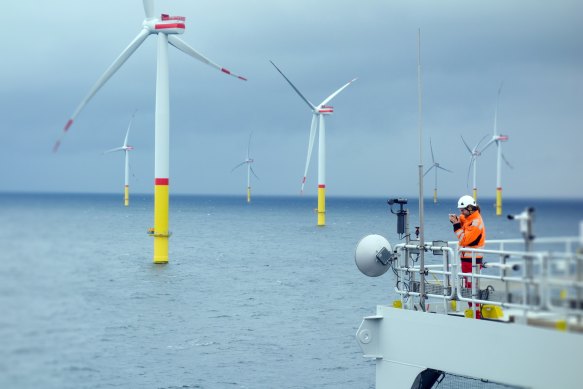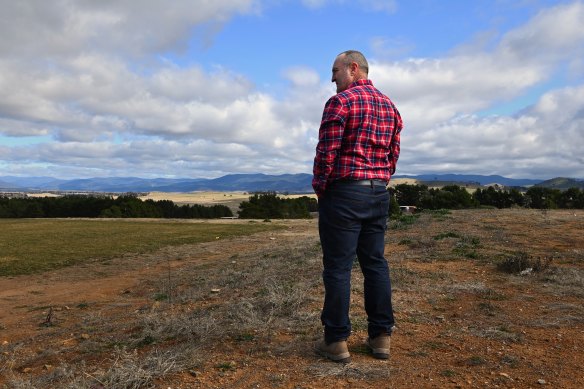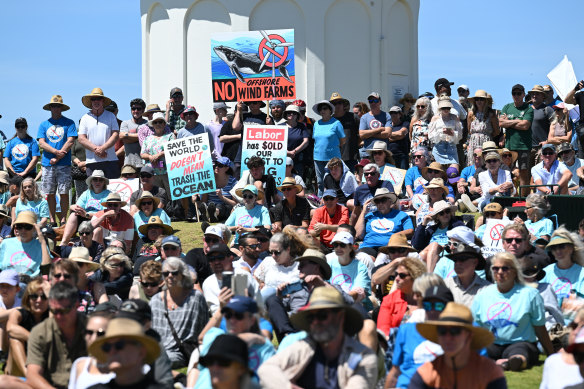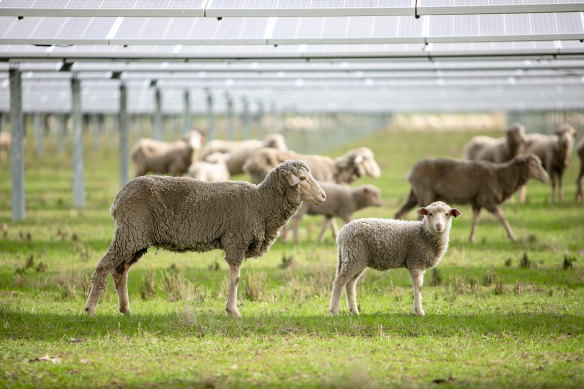
The energy transition is facing headwinds. From Wallaroo to Wimmera, proponents of large-scale wind and solar projects are finding that community engagement is getting harder.
The news this week that Norwegian energy giant Equinor and its Australian partner Oceanex have abandoned plans to apply to develop the Illawarra offshore wind zone highlighted concerns about whether the renewables push is losing the battle for “social licence”.
This concept refers to the acceptance granted to a company or industry by the community. Without it, projects become mired in protests, legal action and negative media coverage, and politicians grow fearful and fretful in making decisions.

Star of the South, 10 kilometres off Gippsland’s south coast, is targeting 2.2GW in capacity. Credit: Getty Images
Equinor insists its decision was financial, while research in regional Australia suggests support for renewables remains strong and people from all demographics are ultimately persuadable.
Peter Lewis, principal of Essential Media, has conducted a lot of this research. He says social licence has to be earned and this is mainly a communication challenge.
“When a development is contested, there is a void that can be filled with misinformation because there is no sense of the broader energy transition plan,” Lewis says. “Politicians talk about acronyms, targets and megawatt hours while people just see a new piece of infrastructure proposed for a place they love.”
RE-Alliance, a not-for-profit organisation working with regional communities to ensure renewables deliver real benefits, commissioned Essential for a survey of 2000 respondents and extensive focus groups in NSW, Queensland and Victoria in regions where the renewables rollout is taking place. RE-Alliance national director Andrew Bray says the findings are evidence for what the organisation has seen on the ground for many years about how different groups of people respond to conversations about renewables.
While a decade ago a developer might build a single wind or solar farm, Bray says, now the discussion could be an entire renewable energy zone. This is a “much bigger deal for the community”, raising questions not just of visual amenity and impact on nature but also accommodation for workers and road usage.

Adam Gresham, 51, a Wallaroo resident overlooking the area slated for a solar farm.Credit: Kate Geraghty
“It all has more momentum and industry and government are certainly much clearer on what needs to happen, but local communities haven’t really been dealt into the discussion at a higher level in a way that I think they should be and need to be,” Bray said.
Loading
The key theme of the research is that communities feel the transition is “being done to them not with them”, and they are being asked to tolerate what they perceive as a net negative. While people recognised the need to transition away from fossil fuels, the research found, they were suspicious about large-scale development in general and distrusted government and energy companies, meaning attempts to provide information could be seen as a “sell job”.
People in coastal communities were genuine in their concerns about the impacts of developments on nature, the research found, but were receptive to information that marine life could co-exist with offshore wind. Many people also raised genuinely held concerns about turbines going into landfill after 10 years and prime agricultural land being lost to renewables development, both points that can be overcome with the right information.
The research found community groups, councils and quasi-independent government agencies such as the CSIRO were more trusted sources of information than traditional media or the Australian government. RE-Alliance is pushing for the federal government to fund local energy hubs to lead conversations on the energy transition in regional areas.

Local residents rallying against the Illawarra offshore wind zone in October 2023, which lost a potential bidder this week.Credit: AAP
A person who sat in on hours worth of focus groups about offshore wind, who asked for anonymity to speak freely, says progressive-leaning men seem the most supportive, while progressive-leaning women are more swayed by worries about spoiling natural beauty and harming the marine environment. Conservative-leaning men understood that there would be some disturbance from any development.
Loading
In the focus group for conservative-leaning women, one of the participants ran a fishing charter business, and she educated the others about how offshore wind farms mimic reefs and wrecks and attract fish.
The debate over offshore wind has been fierce, and nowhere more so than the Illawarra. Wollongong has hosted protests about offshore wind and the government received more than 14,000 submissions, mostly negative, during public consultation. The Gippsland zone, created 18 months earlier, only received 765 submissions.
The federal government ultimately reduced the size of the Illawarra zone by a third. The final size was 1022 square kilometres, compared with 15,000 square kilometres for Gippsland.
Some media commentary suggested Equinor and Oceanex withdrew from the Illawarra zone either because of the size reduction or directly because of community opposition. The companies say otherwise.
Oceanex referred questions to Equinor, which says the decision was “ultimately ... a function of global prioritisation of technical and financial capability across projects in the portfolio”. The companies will focus on their project in the Hunter zone near Newcastle.

Concerns that renewables are taking prime agricultural land are high, but many people are receptive to hearing about how the two can co-exist such as on this set-up with solar panels and sheep.Credit: Chris Grose / Beyond Zero Emissions
In the United States, a string of offshore wind projects from the likes of Equinor, Orsted and BP have fallen over in the past two years. Offshore wind in the US is also hotly contested along partisan lines, though the developers blame supply chain issues and rising interest rates.
The renewables revolution will roll on without Equinor and Oceanex bidding for the Illawarra. There are other companies to bid in the zone, and six other zones around Australia. Offshore wind will be important in the 2030s, but the development of the wind and solar industry on land is well under way and more than 40 per cent of Australia’s electricity is renewable already.
Loading
Clean Energy Council chief executive Kane Thornton says offshore wind has huge potential for Australia, but cautions that it is still “early in the process” and it is essential to consider all community perspectives.
Of course, social licence is equally an issue on land. The common refrain in many communities – such as Wallaroo, NSW near Canberra where a solar farm is proposed – is “we support renewables, but this is the wrong place”.
Acciona Energia, a large infrastructure developer mainly focused on wind and solar in Australia, is finding gaining public acceptance for projects is taking longer.
The company is building the largest wind farm in the Southern Hemisphere, the MacIntyre Wind Farm in the Southern Downs of Queensland, as well as wind projects in NSW, Victoria and South Australia. It is also building large solar farms and transmission infrastructure, including a joint venture for HumeLink East in southern NSW.
Acciona Energia spokesperson William Churchill says the company has been in Australia since 2002 and there has been a “dramatic change” in the past couple of years with the amount of misinformation and disinformation in circulation.
“I wouldn’t say opposition to renewables is hardening, but definitely engagement and consultation is becoming more complex,” Churchill says.
“A lot of our discussions are initially addressing questions about renewables generally before you get into questions about the project specifically. It’s not a problem but it takes longer.”
To answer questions about the carbon footprint of renewables, Acciona has made videos explaining how this is calculated and the payback period. To address fears about renewables taking prime farmland, the company developed videos showcasing interviews with farmers who co-host renewables and livestock. The company has also rebutted claims that renewables are unregulated.
Churchill says it now has to start the community engagement phase, including opening shopfronts and hiring local residents, earlier in a project.
A spokesperson for Climate Change and Energy Minister Chris Bowen says Australia has needed better community engagement around energy infrastructure for years.
“Politicians talk about acronyms, targets and megawatt hours while people just see a new piece of infrastructure proposed for a place they love.”
Peter Lewis, Essential Media
“We want to ensure these communities see long-term material social and economic benefits from energy infrastructure,” the spokesperson says. “Social licence is a whole-of-system effort to get right – for governments, developers and communities working together.”
The government is also implementing the recommendations of the Australian Energy Infrastructure Commissioner’s review of community engagement. One of the ideas is a rating scheme for developers, so communities understand the company’s track record.
In Western Australia recently for the announcement of the offshore wind zone in Bunbury, Bowen told a press conference that every zone announced so far had been adjusted “based on genuine community feedback”.
Loading
Bowen also said some feedback came from people opposed to climate action and others “spreading misinformation and disinformation”.
The problem is highlighted by a recent survey by Ipsos, which found high support for renewables, but also a high propensity to find believable statements such as “electric cars are as bad for the planet as petrol cars” or “offshore wind farms cause harm to whales”. These falsehoods circulate online and are sometimes repeated by politicians.
In his keynote speech at the launch of Climate Action Week on Thursday, Climate Change Authority chair and former NSW Liberal politician Matt Kean took aim at the “cynicism and selfishness” of some in politics.
“Right now the scientific discussion around environmental science is being swamped by ideological rubbish that is sadly often split along party lines,” Kean said.
This makes the task of building social licence harder.
Get to the heart of what’s happening with climate change and the environment. Sign up for our fortnightly Environment newsletter.



























